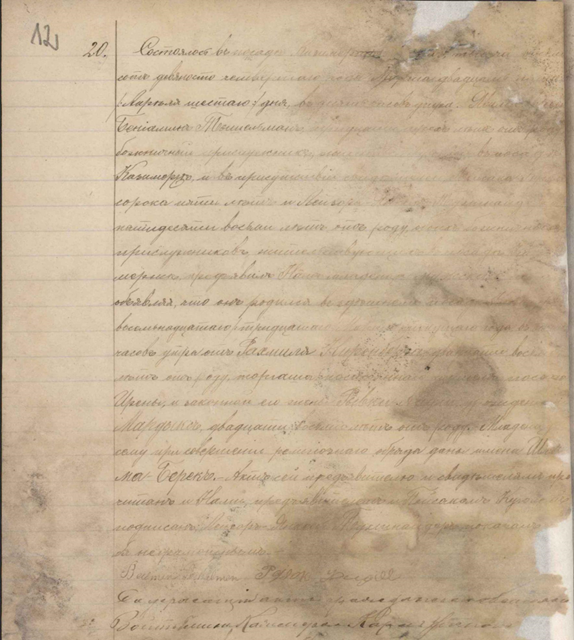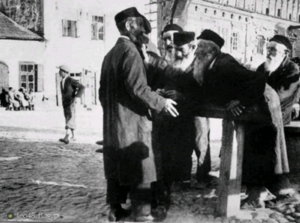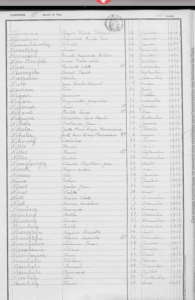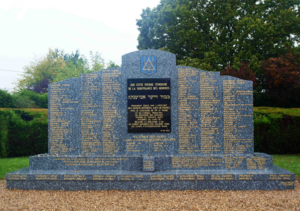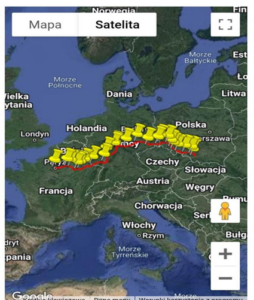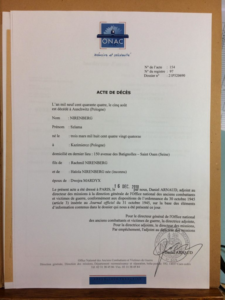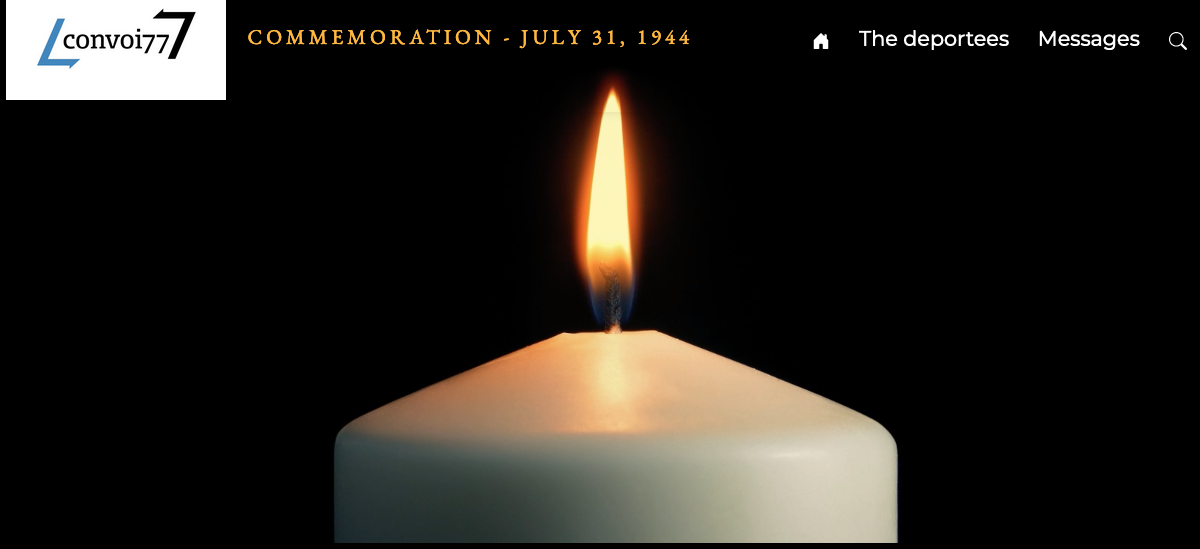Szlama NIRENBERG
Szlama Nirenberg was born on March 3, 1894 in Kazimierz Dolny, in eastern Poland. His parents were Rachmil et Rywka Ajdla, née Mardyks.
Photo: Szlama Nirenberg’s birth certificate.
The Jewish community in Kazimierz Dolny
The first Jews are thought to have settled in Kazimierz Dolny in the second half of the 15th century, although there is evidence that Jewish merchants were active in the region as early as the 11th century. The most prosperous era for the Jewish community was cut short by the impact of wars in the mid-17th century: wars involving the Cossacks of Chmielnicki, the Swedes, Rákóczi’s men and ultimately the Polish army, not to mention fires and the plague.
A group of Jewish men in Kazimierz
In 1939, the population of Kazimierz was 4,641, including around 2,500 Jews. Soon after the start of the Second World War, in 1940, the Germans created a ghetto in the town, in which they confined all the local Jews.
In March 1942, the people living in the ghetto in Kazimierz were transferred to another ghetto in Opole Lubelskie, and then deported to an concentration and extermination camp, most likely Bełżec. When the labor camp was closed down, the Jews who were still alive were deported, and a dozen or so were shot in the autumn of 1943 in the new Jewish cemetery.
Szlama had known his future wife, Dwojra Mardyks, all his life, as their families were related. They were born in the same year, just two months apart, and were first cousins, as Dwojra’s father was Szlama’s mother’s brother. They got married in Siedlce, Dwojra’s home town, and soon moved to Warsaw, where prospects were better.
The Jews in Siedlce
List of children born in Paris, including Maurice, Szlama and Dwojra’s son
The first reference to Jews living in Siedlce dates back to 1577. According to research carried out at the beginning of the 20th century, the earliest traces of them, which are inscriptions on tombstones, date back to 1630. The highest percentage of Jews in Siedlce was recorded in 1865, when the total population of the town was 9710, of whom 7094 (73%) were Jewish. In September 1939, at the very beginning of the war, Siedlice was bombed and a large number of people, including many Jews, were killed. Around 80% of the houses in the town were destroyed, which had a severe impact on the local population. The war decimated the Jews’ livelihoods. In March 1940, around 1,200 Jews from Kalisz and other towns in western Poland were moved to Siedlce, and many of the local Jews were sent to labor camps in the Lublin area. In August 1941, the Germans turned a whole district in Siedlice into a sealed-off ghetto, to which they transferred all the local Jews. Sanitary conditions in the ghetto were abysmal, and in late 1941 and early 1942, a typhus epidemic ravaged the population. Only about a thousand Jews from Siedlce survived the war, most of them having fled to the USSR. Very few returned to their hometown after the war ended in 1945.
Szlama and Dwojra’s first daughter, Anna, was born in 1920. They went on to have two more daughters, Laja and Rachel, in 1922 and 1924. All three girls were born in Warsaw.
At some point between 1924 and 1927, the family emigrated to France. Their first son, Maurice, was born in Paris on February 19, 1927. They probably moved to France for the same reason as they had to Warsaw, which was to give their children the chance of a brighter future and a safer environment.
They lived on the outskirts of Paris, at 150 Avenue des Batignolles, near the village of Saint-Quen, in the Seine-Saint-Denis department of France; before that, they had lived for a while at 21 Boulevard Biron, also in Saint-Ouen. Szlama worked as a custom-made leather glove manufacturer at 11 Rue Elzevir, and Dwojra was a seamstress.
In July 1942, during the largest French roundup of Jews of the Second World War, Szlama went into hiding in his workshop. He owed his survival to a family friend, Mr. Truffat, who warned him that he was in danger and, with the help of the building’s janitor, provided him with essential supplies.
The eldest daughter also survived the roundup; the Truffat family took her in and she stayed with them until 1944, when their apartment was destroyed during the bombings; she survived the war, but we do not know what became of her after that.
The rest of the family was not so lucky. On July 16, 1942, they were arrested during a major roundup of Jews. They were held at the Vélodrome d’Hiver (winter cycling track) until July 19, 1942. They were then sent to the Beaune-la-Rolande camp, in the Loiret department of France. Dwojra and her daughters are thought to have been interned in barrack 3, and Maurice in barrack 7.
The Vél d’Hiv roundup
The Vél d’Hiv roundup, which took place on July 16 and 17, 1942, was the largest mass arrest of French Jews of the Second World War. The pro-German Vichy government, with a task force of around 9,000 police officers, arrested more than 13,000 Jewish people in Paris and the surrounding area. The roundup takes its name from an indoor cycling track, the Vélodrome d’Hiver, which was located near the Eiffel Tower in Paris from 1909 to 1959, and was where the French police detained the victims of the roundup. It was part of the Third Reich’s Europe-wide campaign known as Operation Frühlingswind (Spring Wind).
The Beaune-la-Rolande camp
The Beaune-la-Rolande transit camp, in the Loiret department of France, was a German internment camp for Jews from France and prisoners of war, who were held there prior to being deported to extermination camps in other countries. The building work was completed in May 1941.
As of May 14, 1941, it became part of a network of prison camps for Jews. A transport of 2,773 Polish Jews arrested in France were sent to Beaune-la-Rolande and held there until 1942, when they were deported on Convoy 5 directly to Auschwitz-Birkenau in occupied Poland or transferred to the Drancy internment camp near Paris. A group of around 1,500 children, whose parents had been arrested and interned, were also held in Beaune-la-Rolande. These children were also subsequently transferred to Drancy or deported to Auschwitz. The camp was officially closed on August 4, 1943, although some sources suggest that it remained open until October 1943.
Dwojra and her daughters were first sent to Terezin and from there were deported to Auschwitz on Convoy 15 on August 5, 1942. There is no further trace of them after that, so it is highly likely that they were killed as soon as they arrived.
Szlama remained in hiding until July 10, 1944, when the French police found and arrested him. He was sent to Drancy internment camp near Paris on July 11 or 12.
Two years earlier, his son Maurice, who had been separated from the rest of the family, had been interned in the same camp. He was deported to Auschwitz on Convoy 25 on August 28, 1942.
Monument to the Beaune de Roland transit camp, on which the name Nirenberg is listed.
Drancy camp
Map of Szlama’s journey from France to the extermination camp in Nazi-occupied Poland
Drancy camp was a German-run transit camp for Jews from France and elsewhere in Europe. They were interned there before being deported to concentration and extermination camps outside France, mainly Auschwitz-Birkenau. There were around 58 transports from Drancy to Auschwitz-Birkenau. The camp was operational from August 1941 to August 1944, and a total of around 67,400 people were interned there. The camp was finally closed in 1946, and the buildings were redeveloped and converted into low-cost housing. Drancy is the only site in France listed by Yad Vashem, the World Holocaust Remembrance Center, as a major Jewish extermination site.
Szlama was deported to Auschwitz on Convoy 77 on July 31, 1944. The train arrived on August 3, and he was almost certainly killed as soon as he arrived. His date of death was later declared to be August 5, 1944.
Szlama Nirenberg’s death certificate
Sources
- Archiwum Państwowe w Lublinie: zespół akt nr 1739 – Akta stanu cywilnego Okręgu Bożniczego w Kazimierzu 1826-1915 [2016], sygn. 60, s. 12 (Polish National archives in Lublin , dossier n°1739 – Civil status records of the District of the Synagogue of Kazimierz, 1826-1915 [2016], réf. 60, p. 12.)
- Polish National archives in Siedlce
- Yad Vashem, Israel
- The United States Holocaust Memorial Museum
- Paris archives
- Shoah Memorial in Paris
- Arolsen archives
- Jewish Historical Instutute in Warsaw, Poland
- The Żydowskie Galicja Museum in Kraków, Poland


 Français
Français Polski
Polski